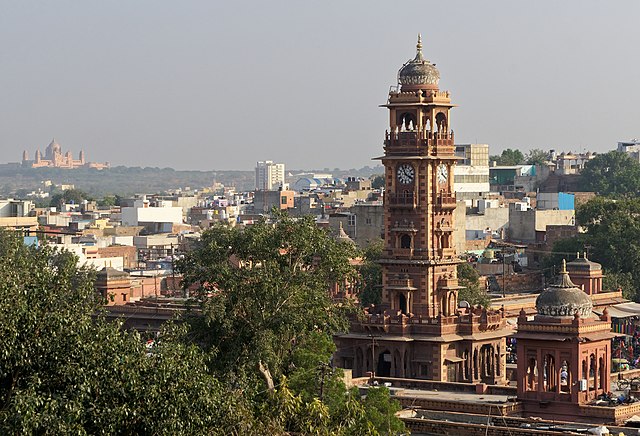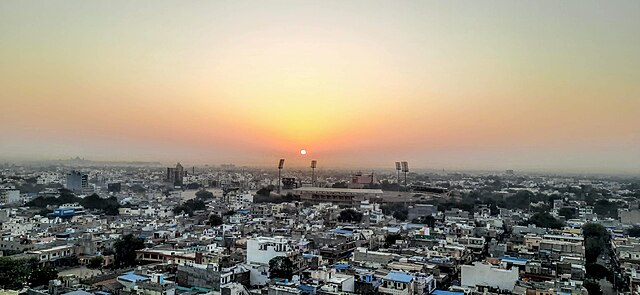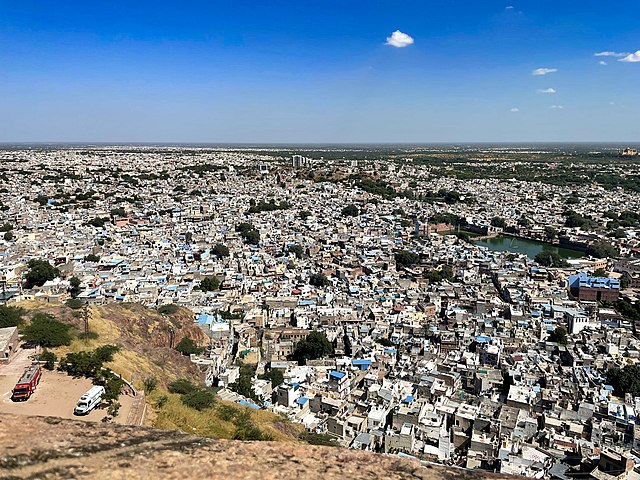Picture this: a sea of indigo-blue houses nestled under a blazing desert sun, with a colossal fort looming over like a guardian of time. That’s Jodhpur for you—Rajasthan’s Blue City, a place where history whispers in every corner, and colors scream louder than words. Founded in 1459 by Rao Jodha, Jodhpur is more than just a city; it’s a living canvas of culture, tradition, and stories that pull you in like a magnet. Why is it blue? Why does it feel like stepping into a fairytale? Let’s dive into the heart of Jodhpur and find out what makes it so unforgettable.
Why Jodhpur Is Called the Blue City
Ever wondered why Jodhpur’s houses are painted blue? It’s not just for Instagram aesthetics, though it sure looks like it. The blue hue, especially in the Brahmpuri area, has practical and cultural roots. The color reflects heat, keeping homes cool in the scorching desert climate. Plus, it’s said to repel insects—pretty smart, right? But there’s more. Blue is sacred to the Brahmin community, and painting homes this shade was a way to honor their heritage. As you wander the narrow lanes, the blue feels like a cool embrace, wrapping you in Jodhpur’s unique identity.
A Historical Perspective on the Blue Hue
The tradition of painting houses blue dates back centuries, likely starting with the Brahmin community. Over time, it spread across the old city, creating a stunning visual that’s now Jodhpur’s hallmark. Walking through these streets feels like stepping into a painting where every shade of blue tells a story of survival, faith, and pride. It’s no wonder travelers can’t resist snapping photos at every turn!
Mehrangarh Fort: The Crown Jewel of Jodhpur

Perched on a rocky hill, Mehrangarh Fort is Jodhpur’s beating heart. This 15th-century fortress is one of India’s largest, and trust me, it’s as grand as it sounds. Its towering walls, intricate carvings, and sprawling courtyards make you feel like you’ve walked into a Game of Thrones set. Built by Rao Jodha, the fort has seen battles, celebrations, and everything in between. Today, it’s a museum showcasing royal artifacts, weapons, and paintings that bring Jodhpur’s history to life.
What to See Inside Mehrangarh Fort
Inside, you’ll find treasures like the Phool Mahal, a room dripping with gold and mirrors, and the Sheesh Mahal, where glasswork sparkles like a starry night. The fort’s museum also houses palanquins, armor, and even a cannon that’s bigger than your car. Don’t miss the zip-lining adventure here—it’s a thrilling way to soak in panoramic views of the Blue City below. Pro tip: visit at sunset for a magical glow that’ll leave you speechless.
Events and Festivals at Mehrangarh
Mehrangarh isn’t just a monument; it’s a cultural hub. The Rajasthan International Folk Festival (RIFF) and World Sacred Spirit Festival draw artists from across the globe, filling the fort with music and mysticism. Imagine sitting under the stars, listening to soulful Rajasthani folk tunes echoing off ancient walls—pure goosebumps!
Jaswant Thada: A Marble Marvel
Just a stone’s throw from Mehrangarh lies Jaswant Thada, a white marble cenotaph that looks like it was carved from a cloud. Built in 1899 for Maharaja Jaswant Singh II, this serene monument is a stark contrast to the rugged fort. Its delicate latticework and tranquil gardens make it a perfect spot to pause and reflect. Why is it so peaceful? Maybe it’s the marble that glows at sunrise or the lake nearby that adds a touch of calm.
Why Jaswant Thada Stands Out
Unlike the imposing forts, Jaswant Thada feels intimate. The intricate jali (lattice) work lets sunlight dance through, creating patterns that are almost hypnotic. It’s also a great place to learn about the royal lineage, with portraits and memorials inside. Pack a picnic and enjoy the gardens—it’s like Jodhpur’s version of a zen retreat.
Umaid Bhawan Palace: Where Royalty Meets Luxury

If you’ve ever dreamed of living like a king, Umaid Bhawan Palace is where that fantasy comes true. This golden-hued palace, built in the 1920s, is part residence, part museum, and part luxury hotel. With 347 rooms, marble floors, and sprawling gardens, it’s a testament to opulence. Fun fact: it was built to provide jobs during a famine—talk about a royal win-win!
Exploring Umaid Bhawan
The museum here is a must-visit, showcasing vintage cars, clocks, and royal memorabilia. If your wallet allows, book a stay at the Taj-managed hotel for a taste of regal life. Strolling the grounds feels like walking through a postcard, with peacocks strutting and the palace glowing under the desert sun.
The Vibrant Culture of Jodhpur
Jodhpur’s culture is like a spicy curry—bold, colorful, and impossible to ignore. From folk music to intricate handicrafts, the city pulses with creativity. Ever heard a Rajasthani ballad? It’s soul-stirring, like the desert itself is singing. The people here are warm, their turbans bright, and their stories endless. Festivals like Diwali and Marwar Festival light up the city with joy and tradition.
Handicrafts and Shopping in Jodhpur
Jodhpur is a shopper’s paradise. Head to Sardar Market or Clock Tower (Ghanta Ghar) for bandhani textiles, leather jootis, and antique furniture. Bargaining is an art here, so channel your inner negotiator! The city’s lacquer work and metal crafts make for perfect souvenirs. Ever tried on a traditional pagdi (turban)? It’s a fun way to feel like a local.
Top Markets to Visit
Besides Sardar Market, check out Mochi Bazaar for shoes and Kapra Bazaar for fabrics. These bustling lanes are a sensory overload—think spices in the air, vendors calling out, and colors popping everywhere. It’s chaotic, but in the best way possible.
Jodhpur’s Culinary Delights
Food in Jodhpur is a love letter to your taste buds. Rajasthani cuisine is hearty, spicy, and oh-so-satisfying. Try dal baati churma, a combo of lentils, baked dough balls, and sweet crumbled wheat. Or dig into mirchi vada, a fiery green chili fritter that’s not for the faint-hearted. Wash it down with makhaniya lassi, a creamy drink that’s like a hug in a glass.
Where to Eat in Jodhpur
For street food, head to the Clock Tower area for pyaaz ki kachori and samosas. Want a royal dining experience? Indique at Pal Haveli offers rooftop views and dishes fit for a maharaja. Don’t leave without trying gatte ki sabzi, a gram flour curry that’s pure comfort food. Hungry yet?
Exploring Beyond the City: Day Trips from Jodhpur

Jodhpur’s charm extends beyond its blue walls. Take a day trip to Bishnoi Village, where you’ll meet a community living in harmony with nature. Spot blackbucks and learn about their eco-friendly lifestyle—it’s humbling. Or visit Mandore Gardens, the ancient capital of Marwar, with its eerie cenotaphs and lush greenery.
Osian: The Desert Oasis
About an hour away, Osian is home to ancient temples and sand dunes. A camel safari here at sunset is like stepping into an Arabian Nights tale. The Jain temples, with their intricate carvings, are a hidden gem for history buffs.
Best Time to Visit Jodhpur
Jodhpur’s desert climate means summers (April-June) are hotter than a tandoor oven. The best time to visit is October to March, when the weather is pleasant, and festivals are in full swing. Winter mornings are crisp, perfect for exploring forts, while evenings call for rooftop cafes and stargazing.
Travel Tips for Jodhpur
Pack light cotton clothes, comfy shoes for those cobbled streets, and sunscreen—trust me, you’ll need it. Stay hydrated, and carry cash for small shops. Hiring a local guide for the fort can unlock stories you won’t find in guidebooks. And don’t shy away from chatting with locals—they’re Jodhpur’s real treasure.
Conclusion: Why Jodhpur Steals Your Heart
Jodhpur isn’t just a destination; it’s an experience that lingers long after you leave. From the towering Mehrangarh Fort to the tranquil Jaswant Thada, from spicy kachoris to blue-hued lanes, every moment here feels like a story unfolding. It’s a city where the past and present dance together, inviting you to join in. So, pack your bags, grab your camera, and let Jodhpur paint your world blue. When are you planning your trip?
FAQs About Jodhpur
1. Why are houses in Jodhpur painted blue?
The blue color helps keep homes cool, repels insects, and holds cultural significance for the Brahmin community, creating Jodhpur’s iconic look.
2. How many days do you need to explore Jodhpur?
A 2-3 day trip is ideal to cover major attractions like Mehrangarh Fort, Jaswant Thada, and the old city, with time for shopping and food.
3. What is the best way to get to Jodhpur?
Jodhpur is well-connected by air, rail, and road. Fly into Jodhpur Airport, take a train to Jodhpur Junction, or drive from Jaipur (about 4 hours).
4. Is Jodhpur safe for solo travelers?
Yes, Jodhpur is generally safe, with friendly locals. Stick to well-lit areas at night and take standard travel precautions.
5. What souvenirs should I buy in Jodhpur?
Pick up bandhani textiles, leather jootis, spices, and handicrafts like lacquer work from markets like Sardar Market or Mochi Bazaar.

